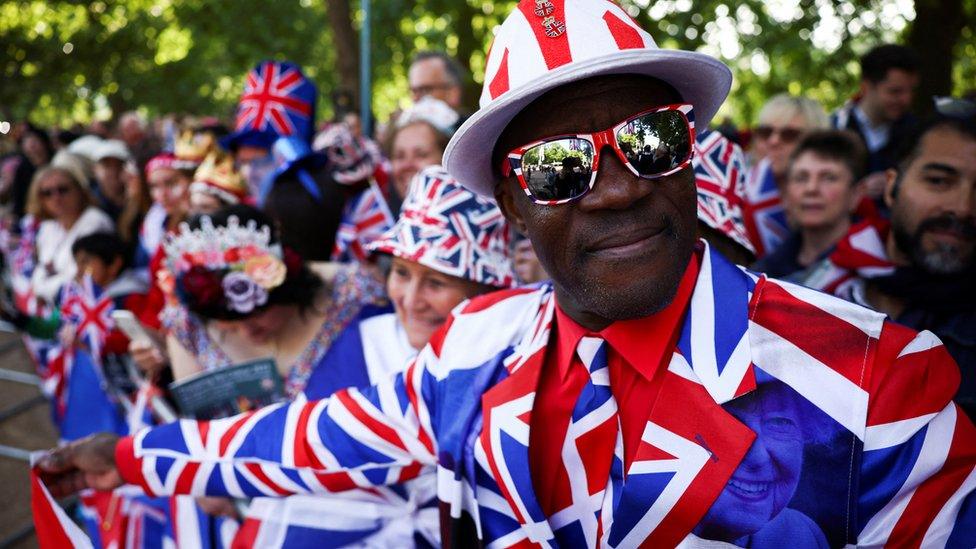Platinum Jubilee: The Queen and the island of Ireland
- Published
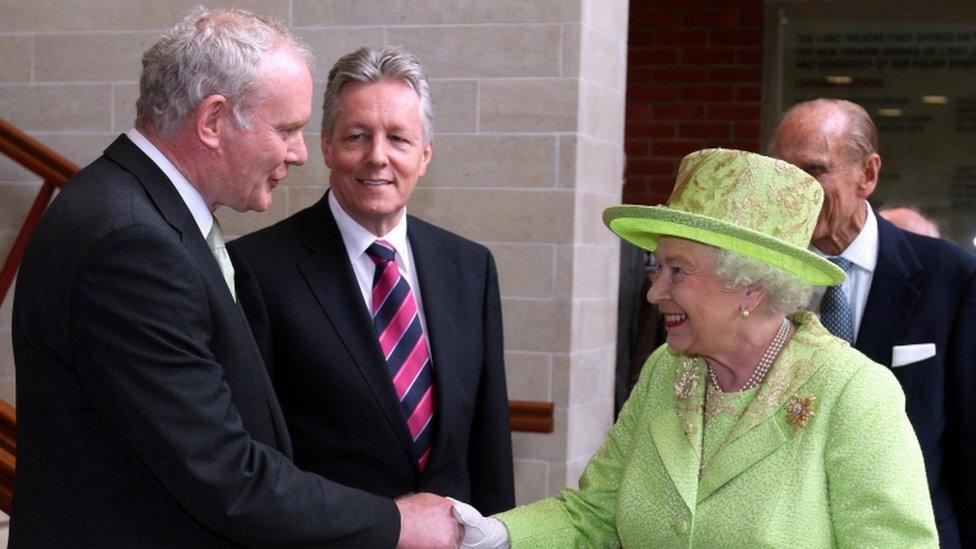
Sinn Féin's Martin McGuinness met the Queen for the first time in June 2012
The early newsreels of royal visits to Northern Ireland show scenes of public euphoria - and feature some interesting facts.
For example - the then Princess Elizabeth's first trip on an aeroplane took her to Long Kesh aerodrome in County Antrim in 1945.
She and her parents went to the seat of Northern Ireland's devolved government at Stormont - and that was her first visit to a parliament anywhere in the world.
From the 1940s to the early 1960s, the black-and-white footage focuses on massive flag-waving crowds cheering the monarch and the Duke of Edinburgh in towns such as Carrickfergus, Lisburn and Bangor.
But beneath the devotion there was tension.
In 1966, an Irish republican protester dropped a concrete block on Queen Elizabeth II's car as she was being driven through Belfast.
No one was injured, but it came to be seen as a grim omen of the conflict which broke out three years later.
The period of violence known as the "Troubles" was complex, but at its centre was the issue of whether Northern Ireland should stay in the United Kingdom.
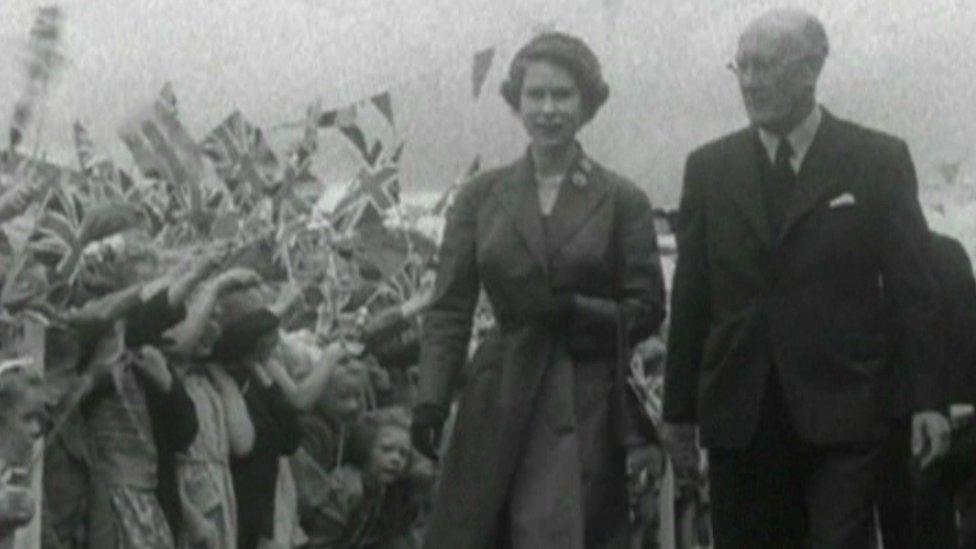
The Queen made a number of visits to Northern Ireland before the Troubles
Tragedy touched the sovereign personally in 1979, when her cousin Lord Mountbatten was murdered in an IRA bomb attack on his fishing boat.
His 14-year-old grandson, Nicholas Knatchbull, and 15-year-old Paul Maxwell, a local boy who was working as a boatman, were also killed in the explosion near Mullaghmore in County Sligo.
Another victim, the Dowager Lady Brabourne, died the following day.
Throughout the conflict, relations between London and Dublin were fraught.
But the Queen's role in repairing and strengthening the links between Britain and Ireland were critical in creating the climate for peace.
Mary Robinson told me that when she became the seventh President of Ireland in 1990, none of her predecessors had "done anything public" in Britain.
She first met Prince Philip over breakfast, when she travelled to Cambridge to receive an honorary degree.
Then, in May 1993, she met the Queen for tea in Buckingham Palace - the first ever meeting between the heads of state of Britain and Ireland.

Mary Robinson met the Queen at Buckingham Palace in 1993
'An important moment'
Mary Robinson told me how she remembered "the biggest bank of camera crews I had ever experienced" waiting for them outside a door.
"The symbolism of that, two heads of state, two women, equal in office, standing there, it meant a huge amount. That was such an important moment."
The timing was significant.
"There was some hope of an IRA ceasefire. It hadn't happened yet, but there were a lot of things happening," she said.
And there were possibly the first musings about a hugely important event, which would finally happen 18 years later.
"I remember saying to her that it would be lovely for her to come and visit Ireland. Her eyes lit up and she said: 'You have no idea how much that would please me'."
The links between the palace and the presidency continued and deepened during the term of Mrs Robinson's successor, Mary McAleese.
In May 2011 - 66 years after her first flight took her across the Irish Sea - the Queen took another short plane journey westwards.
But this time, she landed on the other side of the border, and became the first British monarch to visit the Republic of Ireland.
The state visit was laden with healing and historic gestures.
For Mrs Robinson, one of the most significant came when the Queen laid a wreath at the Garden of Remembrance in Dublin, which commemorates those who fought against Britain to achieve Irish independence.
"When she bowed her head in that particular way, she knew exactly what she was doing, she knew exactly how much to bow," Mrs Robinson said.
The former president became visibly emotional when she contemplated the moment.
"Everyone in Ireland saw that, and it symbolised that she profoundly understood that we had to become good neighbours."
She was worried about the potential of violence around the royal visit - "at the start, there was tension in the air".
But she saw how the Queen "transformed something" through "understanding what the Irish people expected of her".
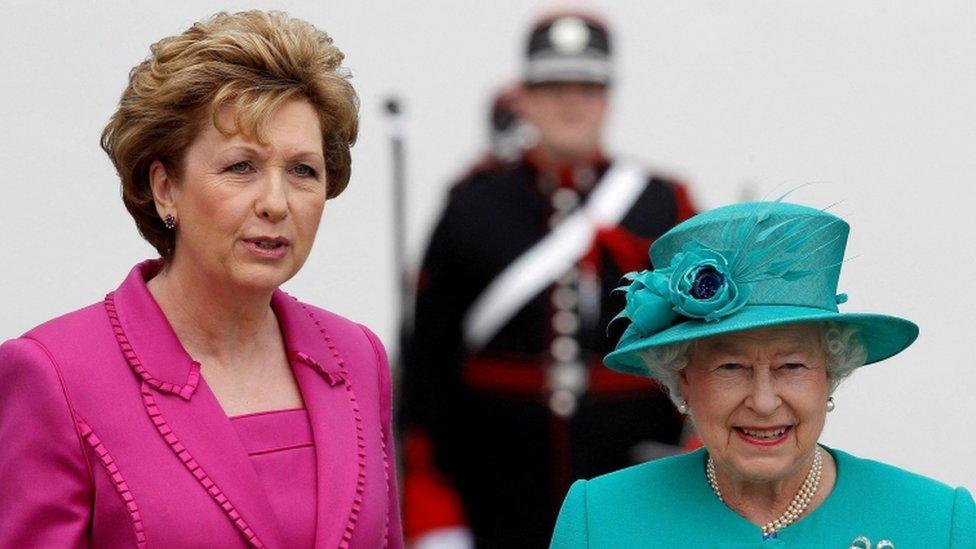
Ireland's President Mary McAleese welcomed the Queen to Dublin in 2011
"She became a very popular figure in Ireland, and she still is."
Another defining image of the changed times on the island of Ireland came a year later.
The Queen shook hands with Martin McGuinness - a former commander in the paramilitary group which took the life of Lord Mountbatten.
The political party which grew out of the IRA, Sinn Féin, had become the second biggest in Northern Ireland - meaning Mr McGuinness was deputy first minister in the power-sharing devolved government.
The handshake happened at an event in the Lyric Theatre in Belfast, organised by the peace-building organisation Co-Operation Ireland.
Its chief executive Peter Sheridan was standing next to the royal and the republican when they met.
"I remember saying to myself as the Queen came round the corner, that I was going to take the time, almost in slow motion to watch this happening," he said.
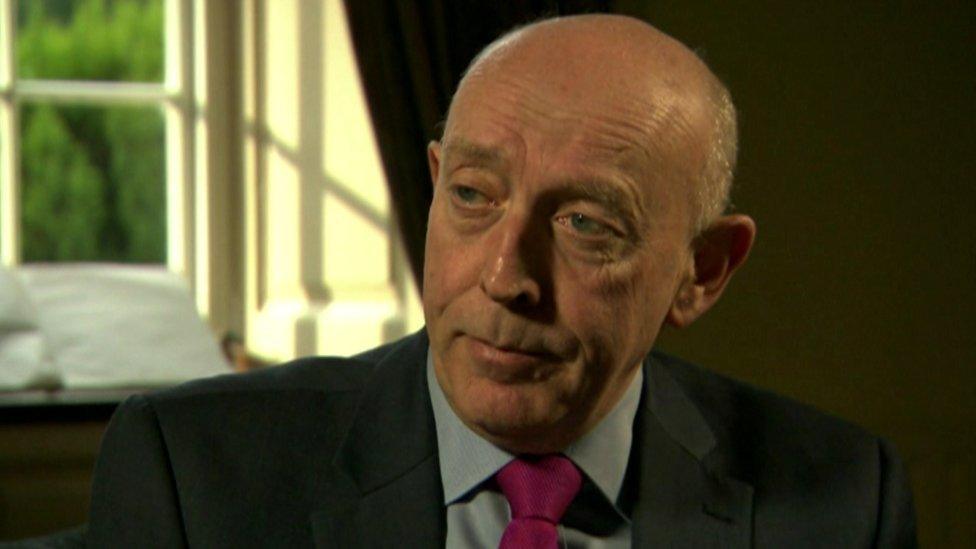
Peter Sheridan was present for the famous hand-shake between Martin McGuinness and the Queen
"You could not help but feel that you were witnessing a moment of significant history.
"It demonstrated the cementing of the peace process. I think we send an enormous message of hope to people in other conflict zones around the world."
The Queen and the President of Ireland are the joint patrons of Co-Operation Ireland - which helped to lay much groundwork for the seismic symbolism of 2011 and 2012.
Mr Sheridan remembers the Queen's speech at a dinner in Dublin Castle during the state visit as being "a masterstroke in reconciliation".
"She talked about the need to bow to the past, but not be bound by it," he said.
"Her Majesty is a human being, and she feels loss like all the rest of us.
"I think what she was saying was that it didn't matter what side you come from. I think those remarks resonated with anybody who had been a victim."
The sovereign's relationship with Northern Ireland reflects a story which is both harrowing and hopeful.
Those dimensions were in the mind of Colin Davidson, when he painted her portrait in 2016.
The Queen sat with the artist from County Down for two hours, for a work commissioned by Co-Operation Ireland.
As he showed me his drawings from that time, Mr Davidson remembered her "intense wit, good humour and warm smile".
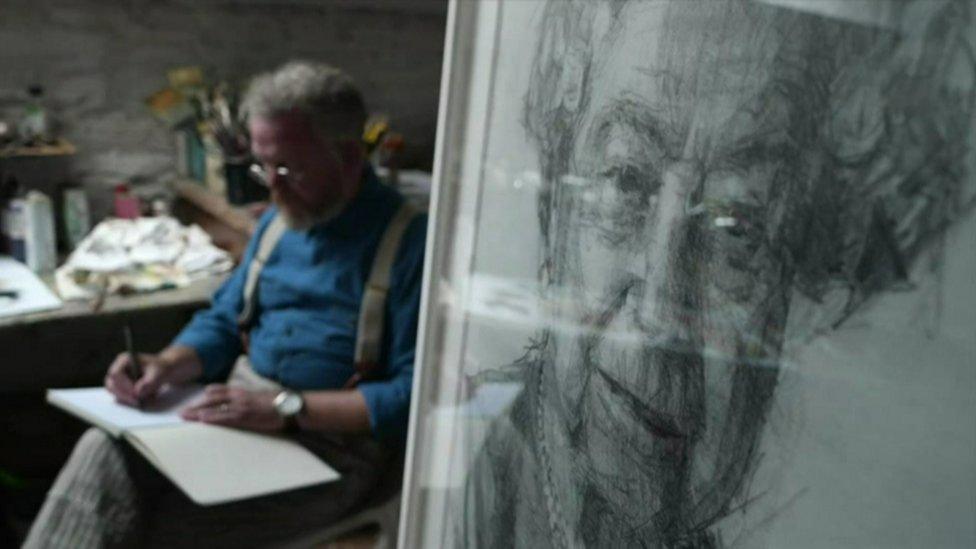
Colin Davidson painted the Queen's portrait in 2016
He recounted how she chose to wear "none of the trappings of the Crown" for the sitting, which to him showed "the British head of state was very aware this was an Irish painting of her".
It seemed clear to Mr Davidson from the time he spent with the monarch that "being on the throne when there was the opportunity for peace in Ireland was very important to her".
He expressed his hope that the portrait would capture something of her peace-building legacy for future generations.
He summed up her contribution like this: "The Queen, who suffered personal loss during the Troubles, reached out the hand of friendship and forbearance."
Related topics
- Published31 May 2022

- Published2 June 2022
